
Concept explainers
(1)
Compute days’ sales uncollected and comment on the changes in the ratios from December 31, 2014 to December 31, 2015.
(1)
Explanation of Solution
Days’ sales uncollected: This ratio is used to determine the number of days a particular company takes to collect accounts receivables.
For December 31, 2014:
For December 31, 2015:
Analysis and comment on changes:
The days’ sales turnover has increased rapidly from 42.9 days (December 31, 2014) to 48.5 days (December 31, 2015) and hence the ratio has worsened.
(2)
Compute
(2)
Explanation of Solution
Accounts receivable turnover: Receivables turnover ratio is mainly used to evaluate the collection process efficiency. It helps the company to know the number of times the accounts receivable is collected in a particular time period. This ratio is determined by dividing credit sales and average accounts receivable.
For December 31, 2014:
For December 31, 2015:
Analysis and comment on changes:
The receivables turnover ratio declined from 9.4 times (December 31, 2014) to 8.9 times (December 31, 2015) and hence the ratio has worsened.
(3)
Compute inventory turnover, and comment on the changes in the ratios from December 31, 2014 to December 31, 2015.
(3)
Explanation of Solution
Inventory turnover: Inventory turnover ratio is used to determine the number of times inventory used or sold during the particular accounting period.
For December 31, 2014:
For December 31, 2015
Analysis and comment on changes:
The inventory turnover ratio declined from 5.1 times (December 31, 2014) to 4.2 times (December 31, 2015) and hence the ratio has worsened.
(4)
Compute days’ sales in inventory and comment on the changes in the ratios from December 31, 2014 to December 31, 2015.
(4)
Explanation of Solution
Days’ sales in inventory: Days’ in inventory is determined as the number of days a particular company takes to make sales of the inventory available with them.
For December 31, 2014:
For December 31, 2015:
Analysis and comment on changes:
The day’s in inventory has increased rapidly from 87.2 days (December 31, 2014) to 99.85 times (December 31, 2015) and hence the ratio has worsened.
Want to see more full solutions like this?
Chapter 17 Solutions
Principles of Financial Accounting, Chapters 1-17 - With Access (Looseleaf)

 AccountingAccountingISBN:9781337272094Author:WARREN, Carl S., Reeve, James M., Duchac, Jonathan E.Publisher:Cengage Learning,
AccountingAccountingISBN:9781337272094Author:WARREN, Carl S., Reeve, James M., Duchac, Jonathan E.Publisher:Cengage Learning, Accounting Information SystemsAccountingISBN:9781337619202Author:Hall, James A.Publisher:Cengage Learning,
Accounting Information SystemsAccountingISBN:9781337619202Author:Hall, James A.Publisher:Cengage Learning, Horngren's Cost Accounting: A Managerial Emphasis...AccountingISBN:9780134475585Author:Srikant M. Datar, Madhav V. RajanPublisher:PEARSON
Horngren's Cost Accounting: A Managerial Emphasis...AccountingISBN:9780134475585Author:Srikant M. Datar, Madhav V. RajanPublisher:PEARSON Intermediate AccountingAccountingISBN:9781259722660Author:J. David Spiceland, Mark W. Nelson, Wayne M ThomasPublisher:McGraw-Hill Education
Intermediate AccountingAccountingISBN:9781259722660Author:J. David Spiceland, Mark W. Nelson, Wayne M ThomasPublisher:McGraw-Hill Education Financial and Managerial AccountingAccountingISBN:9781259726705Author:John J Wild, Ken W. Shaw, Barbara Chiappetta Fundamental Accounting PrinciplesPublisher:McGraw-Hill Education
Financial and Managerial AccountingAccountingISBN:9781259726705Author:John J Wild, Ken W. Shaw, Barbara Chiappetta Fundamental Accounting PrinciplesPublisher:McGraw-Hill Education





